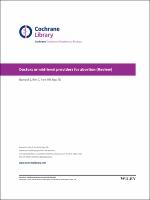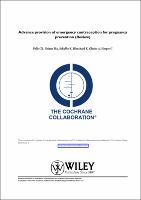| dc.description.abstract | BACKGROUND: The World Health Organization recommends that abortion can be provided at the lowest level of the healthcare system. Training mid-level providers, such as midwives, nurses and other non-physician providers, to conduct first trimester aspiration abortions and manage medical abortions has been proposed as a way to increase women's access to safe abortion procedures. OBJECTIVES: To assess the safety and effectiveness of abortion procedures administered by mid-level providers compared to doctors. SEARCH METHODS: We searched the CENTRAL Issue 7, MEDLINE and POPLINE databases for comparative studies of doctor and mid-level providers of abortion services. We searched for studies published in any language from January 1980 until 15 August 2014. SELECTION CRITERIA: Randomised controlled trials (RCTs) (clustered or not clustered), prospective cohort studies or observational studies that compared the safety or effectiveness (or both) of any type of first trimester abortion procedure, administered by any type of mid-level provider or doctors, were eligible for inclusion in the review. DATA COLLECTION AND ANALYSIS: Two independent review authors screened abstracts for eligibility and double-extracted data from the included studies using a pre-tested form. We meta-analysed primary outcome data using both fixed-effect and random-effects models to obtain pooled risk ratios (RR) with 95% confidence intervals (CIs). We carried out separate analyses by study design (RCT or cohort) and type of abortion procedure (medical versus surgical). MAIN RESULTS: Eight studies involving 22,018 participants met our eligibility criteria. Five studies (n = 18,962) assessed the safety and effectiveness of surgical abortion procedures administered by mid-level providers compared to doctors. Three studies (n = 3056) assessed the safety and effectiveness of medical abortion procedures. The surgical abortion studies (one RCT and four cohort studies) were carried out in the United States, India, South Africa and Vietnam. The medical abortion studies (two RCTs and one cohort study) were carried out in India, Sweden and Nepal. The studies included women with gestational ages up to 14 weeks for surgical abortion and nine weeks for medical abortion.Risk of selection bias was considered to be low in the three RCTs, unclear in four observational studies and high in one observational study. Concealment bias was considered to be low in the three RCTs and high in all five observational studies. Although none of the eight studies performed blinding of the participants to the provider type, we considered the performance bias to be low as this is part of the intervention. Detection bias was considered to be high in all eight studies as none of the eight studies preformed blinding of the outcome assessment. Attrition bias was low in seven studies and high in one, with over 20% attrition. We considered six studies to have unclear risk of selective reporting bias as their protocols had not been published. The remaining two studies had published their protocols. Few other sources of bias were found.Based on an analysis of three cohort studies, the risk of surgical abortion failure was significantly higher when provided by mid-level providers than when procedures were administered by doctors (RR 2.25, 95% CI 1.38 to 3.68), however the quality of evidence for this outcome was deemed to be very low. For surgical abortion procedures, we found no significant differences in the risk of complications between mid-level providers and doctors (RR 0.99, 95% CI 0.17 to 5.70 from RCTs; RR 1.38, 95% CI 0.70 to 2.72 from observational studies). When we combined the data for failure and complications for surgical abortion we found no significant differences between mid-level providers and doctors in both the observational study analysis (RR 1.36, 95% CI 0.86 to 2.14) and the RCT analysis (RR 3.07, 95% CI 0.16 to 59.08). The quality of evidence of the outcome for RCT studies was considered to be low and for observational studies very low. For medical abortion procedures the risk of failure was not different for mid-level providers or doctors (RR 0.81, 95% CI 0.48 to 1.36 from RCTs; RR 1.09, 95% CI 0.63 to 1.88 from observational studies). The quality of evidence of this outcome for the RCT analysis was considered to be high, although the quality of evidence of the observational studies was considered to be very low. There were no complications reported in the three medical abortion studies. | es_ES |



